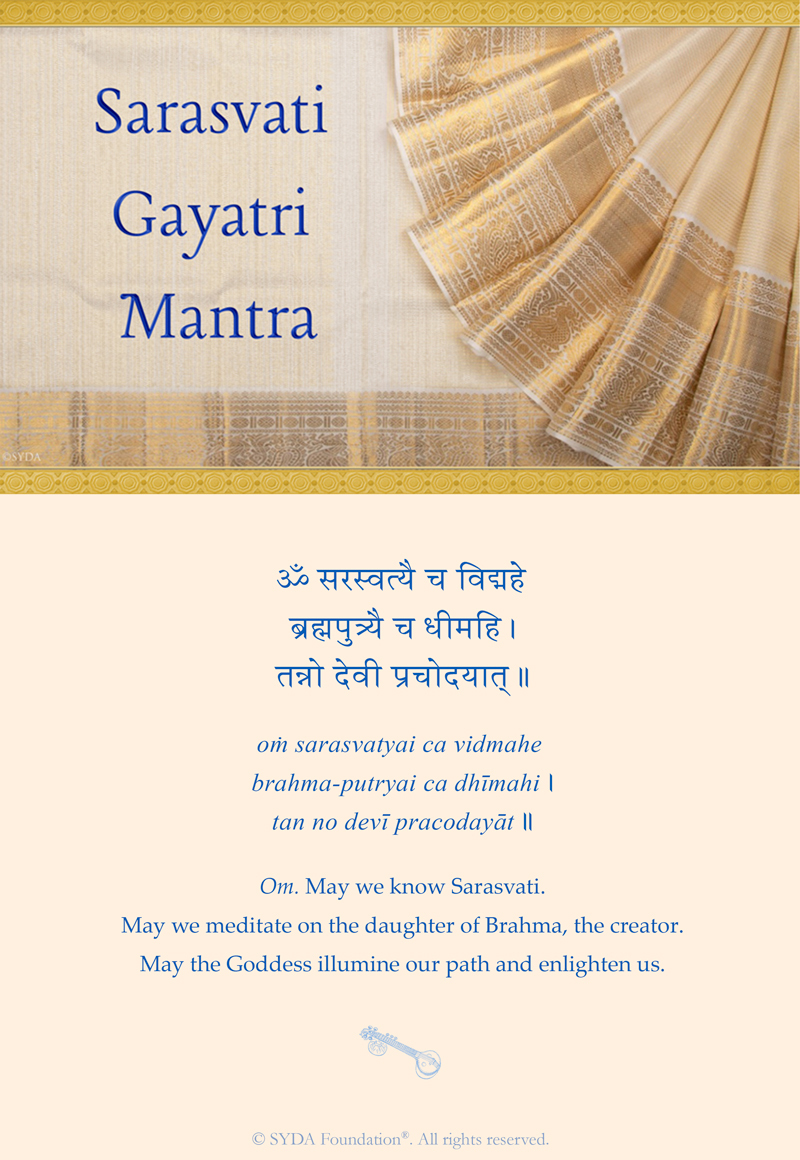Sarasvati Gayatri Mantra

Introduction by Sunil Bahirat
Picture the bejeweled and enchanting goddess Sarasvati holding a veena in her arms while behind her a beautiful river flows. These symbols speak of the deity’s magnificent qualities. The river’s abundance and ever-flowing nature suggest the goddess’s life-giving and rejuvenating essence. The veena, with its range of tones and timbres, is the source of beautiful music. The goddess inspires creativity. Indeed, she is a manifestation of the creative force of the universe
Years ago, I heard a story from the Indian tradition that, in bringing forth the entire world, Lord Brahma needed to establish order in his magnificent creation. His prayers to Lord Vishnu and Lord Shiva were answered in the form of the goddess Sarasvati, who embodied and manifested as the supreme creative force. It was Sarasvati who organized the rotation of the planets, who created night and day and the phases of the moon, who brought order to every aspect of creation. This goddess continues to manifest through every creative act in our lives, large and small.
Throughout India, Sarasvati is revered and honored as the goddess of music, art, speech, knowledge, and learning. Traditionally, musicians, poets, and artists invoke her blessings by reciting rounds of the Sarasvati Gayatri mantra before embarking on a creative endeavor. Writers and speakers refine and purify their words by honoring the goddess through these mantras, as do students of all ages who invoke her presence to support their studies.
On the Siddha Yoga path, students often invoke the blessings of Sarasvati when preparing to study the Gurus’ teachings. The recitation of the Sarasvati Gayatri mantra serves to prepare the students’ minds to focus and understand the teachings they are studying.
I was fortunate to be introduced to Sarasvati at a very young age when my schoolteacher would lead us at the beginning of each school day in a set of mantras dedicated to the goddess. I can still hear the sweet sound of young children’s voices reciting these mantras throughout the school. Feelings of sacredness and serenity would settle inside me each morning, and I recall how this practice prepared my mind for learning. These early memories established in me an appreciation and a loving connection to the goddess, one that has deepened over time.
This ancient mantra comes from the Yajur Veda, one of the earliest scriptural texts of India. Similar to gayatri mantras dedicated to other deities, the Sarasvati Gayatri is written in the classic twenty-four-meter tradition with twenty-four syllables organized inside a triplet of eight syllables apiece. Tradition says that each of the twenty-four syllables represents an aspect of Devi Sarasvati, among them purity, discrimination, peacefulness, and a keen intellect.
Recitation of the Sarasvati Gayatri mantra holds a special place during the celebration of Vasant Panchami, the fifth day of the spring season of the Hindu month of Magha. This sacred day is celebrated as the birth of Sarasvati. Amid the abundant yellow of India’s then-ripening mustard crop, many dress in yellow clothes in honor of this Devi whose favorite color is said to be yellow. Special morning pujas are arranged to recite the Sarasvati Gayatri mantra to invoke the blessings of the goddess.
What I have learned through my experience of reciting this mantra is that it has the power to purify and elevate speech, vak. I find my words becoming simpler and clearer. Intuitively, I know what needs to be said. I also find that listening to the recitation of the Sarasvati Gayatri mantra can illumine my mind and rejuvenate my heart with enthusiasm.
I encourage you to cultivate the practice of reciting this mantra to inspire your words, to bring music and poetry into your life, and to invoke all the abundant blessings of the goddess who abides within the very syllables themselves.


